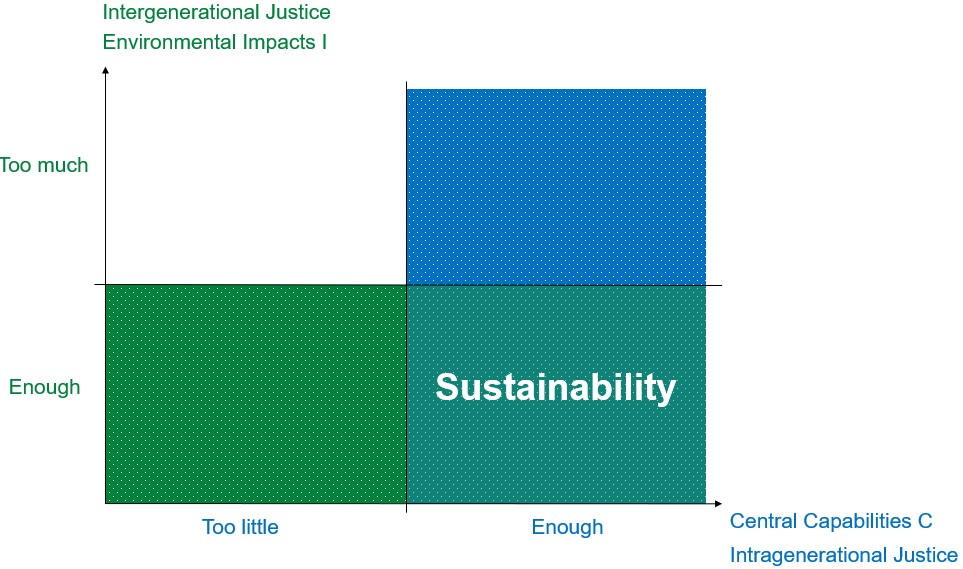Sustainability Strategies – What’s in a Name?
Recently, our world is facing multiple sustainability crises, from climate change to biodiversity loss. We know we must act—but what, exactly, should we be doing? Many discussions revolve around “sustainability strategies” like efficiency, consistency, and sufficiency, but these terms are often used vaguely, without a solid conceptual foundation. The good news is that a new framework aims to bring clarity to these strategies and how they can be systematically put into practice.
The core idea: two interconnected goals must be met simultaneously. First, we need to limit our environmental impacts so that future generations can thrive. Second, we need to guarantee everyone alive today certain central “capabilities”, such as access to food, healthcare, education, and a healthy environment. These capabilities come from the work of philosopher Martha Nussbaum and highlight that real human development is about enhancing people’s freedoms and opportunities—not just boosting economic indicators.
Building on these two goals, the paper identifies ten sustainability strategies, divided into two groups:
Intergenerational Strategies (focusing on reducing and limiting environmental impacts):
- Population Reduction: Reducing population growth and size voluntarily through, for instance, better family planning and reproductive healthcare.
- Sufficiency: Consuming and producing less —to cut down on unnecessary environmental impacts without harming central capabilities.
- Efficiency Increase: Producing or consuming a certain amount of goods with fewer resources and less pollution—think improved fuel efficiency in cars or energy-saving appliances.
- Consistency Increase: Making industrial processes and consumption align better with natural cycles, like recycling and circular design, or using renewable energy.
- Regeneration Expansion: Creating processes that reduce absolute environmental pressure and restore the environment—activities such as reforestation or carbon removal methods.
Intragenerational Strategies (focusing on ensuring everyone’s central capabilities):
- Capability Empowerment: Targeting essential areas like nutrition, healthcare, and education so that people can live dignified, healthy lives.
- Equalization: Ensuring fair access to resources and reducing extreme inequality, so that one group’s overconsumption doesn’t deprive others of the basics.
- Eco-Efficiency Increase: Increasing possibilities of production and consumption through efficiency, consistency and regeneration may specifically help those in need.
- Impact Expansion: Where resources are far below environmental limits, allowing increased production and consumption by expanding environmental impacts to support human development—historically significant but strongly constrained today.
- Population Reduction (again): Distributing environmental impacts and produced goods on a smaller population might foster central capabilities.

Looking ahead, these strategies need to be combined in ways that suit different regional, national, and global contexts. Governing bodies might focus on boosting equal access to healthcare and education (capability empowerment), while simultaneously requiring industry to invest in efficient, consistent, and—where feasible—regenerative technologies. In the global north, levels of consumption and production might have to decrease (sufficiency). Furthermore, consumption and environmental pollution could be equalized globally to allow flourishing within limits to everybody (equalization).
Sustainability requires a holistic approach. Only by balancing environmental impacts and central capabilities can we create a just and sustainable future for all. The presented sustainability strategy framework may help stimulate the transfer and implementation of concrete measures across different sustainability areas. Further research is necessary to investigate current levels of implementation, additional potential, and limitations of the different strategies.
Full Article (Open Access):
Hartmann, E. (2025). Sustainability Strategies: What’s in a Name? A Conceptual Restatement of Fundamental Mechanisms Toward Sustainability. Sustainable Development, article sd.3443. https://doi.org/10.1002/sd.3443